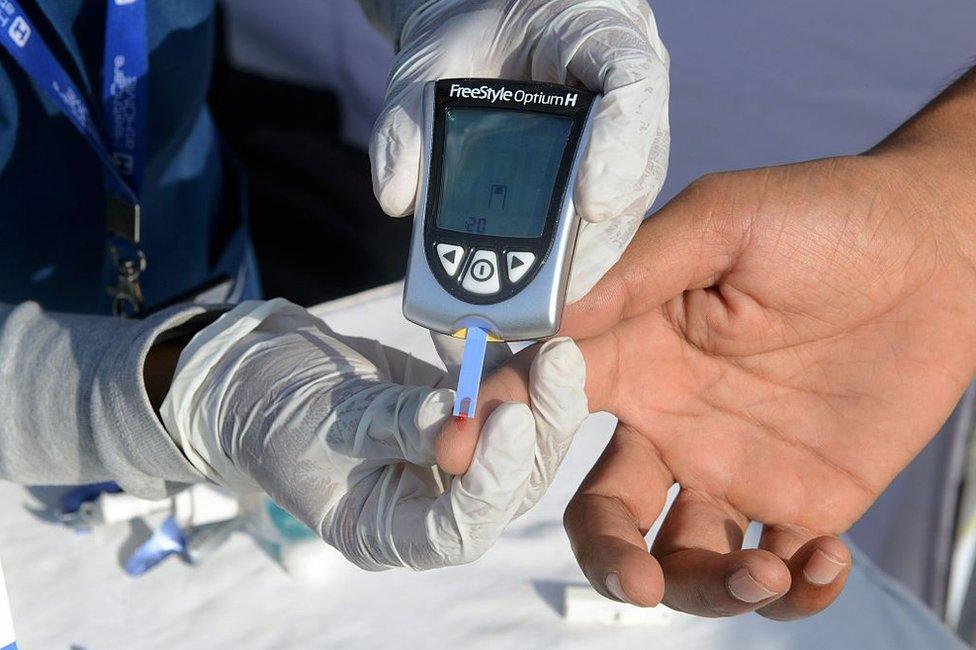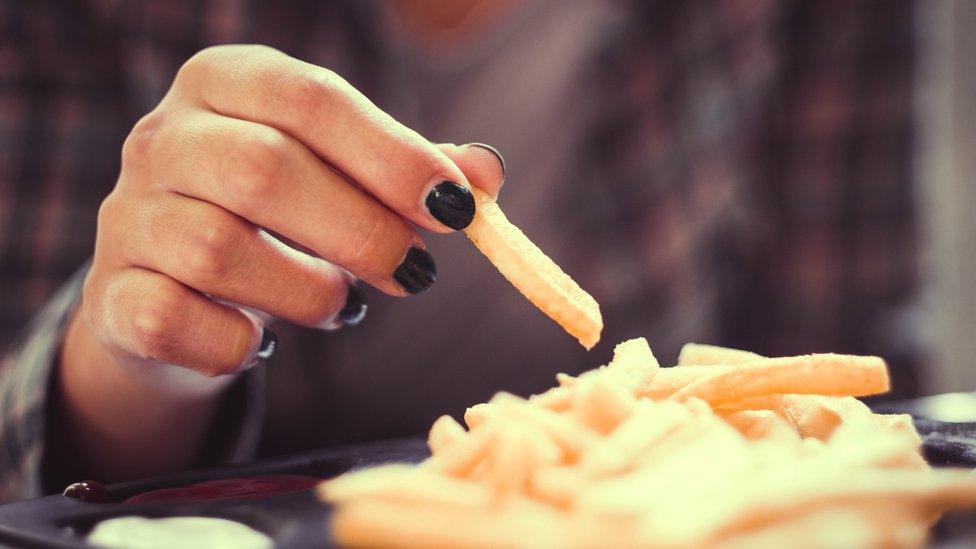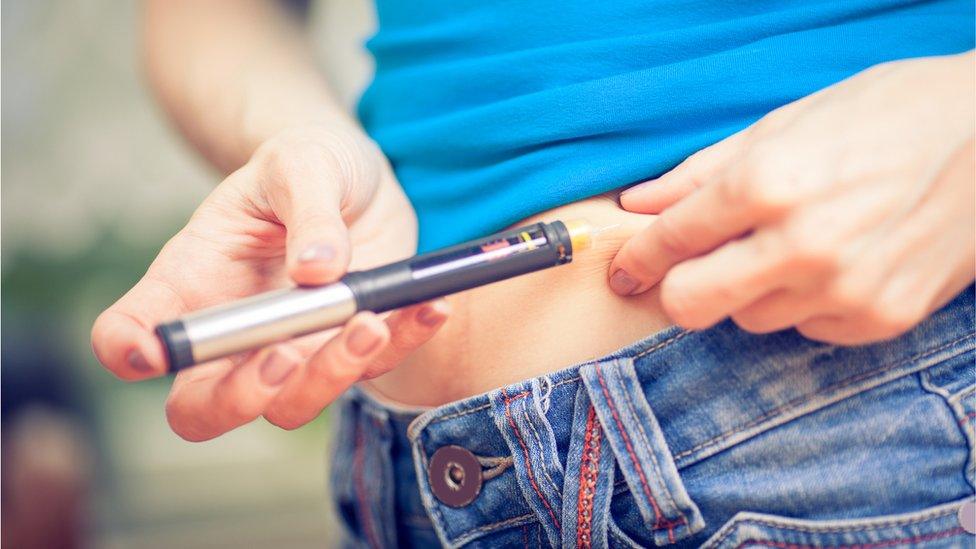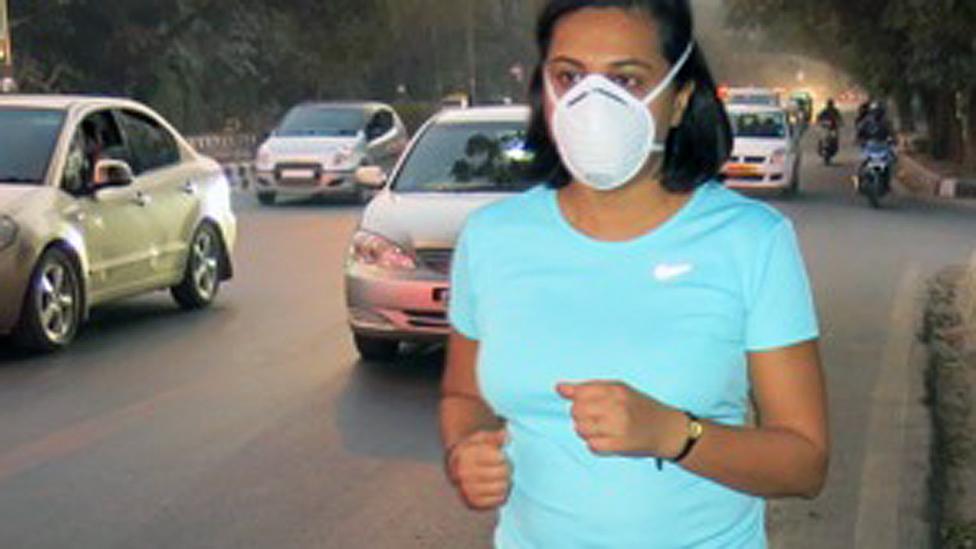Is the world heading for an insulin shortage?
- Published

More than half of people with type 2 diabetes live in China, India and the US
It has been called the scourge of urban life. Poor lifestyle and obesity have led to a surge in type 2 diabetes, a condition that occurs when the body cannot produce enough insulin to regulate blood sugar levels.
Now scientists say that millions of people around the world with diabetes may not be able to access insulin over the next decade and more.
Some 400 million people - more than half of them in China, India and the US - aged 20 to 79, are living with type 2 diabetes, which is the most common form of the disease. Their numbers are expected to climb to more than 500 million by 2030. (The other form is type 1 diabetes in which the body attacks its own insulin-producing pancreatic cells.)
A new study in the Lancet Diabetes and Endocrinology journal says nearly 80 million people with the disease will require insulin by 2030, external as the demand for the drug is projected to rise by 20% by then. But around half of those who need it - possibly the majority in Asia and Africa - will not be able to get it. Already, one in two people with type 2 diabetes do not have access to the insulin they need.
"Access is defined as the combination of availability and affordability," Dr Sanjay Basu from Stanford University in the US, who led the research, told me. "In addition to prices, it also means that a supply chain must be in place that can handle and safely distribute a refrigerated drug and the various supplies like sterile needles and syringes that must go along with it."
Why has insulin, a 97-year-old drug, which was hailed as one of the first "wonder drugs" of the 20th Century, remained consistently expensive over the years?
One reason, say scientists, is that three multinational companies - Novo Nordisk, Eli Lilly and Company, and Sanofi - control 99% of the $21bn (£16bn) global insulin market in terms of value and 96% in terms of volume. (The same companies control the entire US market.)
Global control
And although more than 90 of 132 countries have no tariffs for insulin, the drug still remains expensive for many, external - taxes, steep mark-ups, and other supply chain costs have pushed up the drug price and hurt affordability.
Even in the US, where more than 20 million people have been diagnosed as diabetic, out-of-pocket expenses for insulin increased by 89% between 2000 and 2010. This is true even for adults who are covered under insurance. The price of the drug shot up from $40 a vial to $130 a vial - each vial usually lasts for a couple of weeks at the most.
There are also questions about the availability of the drug.

Some with type 2 diabetes control their blood sugar levels with exercise and a healthy diet
The global control of the insulin market, according to David Henri Beran of Geneva University Hospitals and University of Geneva, means that countries have a small number of suppliers to choose from, "and this factor has resulted in people having to change the type of insulin they take as companies have withdrawn (some) formulations from the market".
There are different types of insulin and doctors prescribe the type that is the most beneficial to patients depending on how they respond to the drug, lifestyle choices, the patient's age, blood sugar goals and the number of injections to be taken every day.
Several low and middle income countries are especially vulnerable to disruptions in supply. A study of insulin availability found supplies were low in six countries - Bangladesh, Brazil, Malawi, Nepal, Pakistan and Sri Lanka. Also poor management and inefficient distribution can lead to disruptions - in Mozambique, for example, 77% of the total supply of insulin remained in the capital city, resulting in shortages in the rest of the country.
"Globally, problems of affordability and availability of insulin are threats to life and challenge the very concept of a right to health," says Dr Beran.
So why is a drug that was discovered nearly 100 years ago by two scientists at the University of Toronto still not available as a low-priced generic? (The scientists sold the patent to the university for $1.) Drugs which are in high demand usually become more accessible after their patents expire, thanks to cheap generic competitors. But that did not happen in this case.

Some 33 million people who need insulin already don't have access to it
One reason, say scientists Jeremy A Greene and Kevin Riggs, is that insulin, which is a hormone produced by living cells, is more complex and harder to copy. And generic drug companies, they add, have not considered it "worthwhile" to do so. Biosimilar insulins, which are similar to insulin, are also available in the market and offer more competitive prices, but they fall short of a generic version.
Scientists say insulin should be included in universal health coverage packages and diabetes funders should allocate a part of their funds for innovation in the delivery of care and the drug.
Clearly, weak health systems, poor access to health facilities, health care delivery of diabetes care and pricing are all impeding access to insulin.
"Quite a few things need to happen, including the price and infrastructure to distribute," says Dr Basu. Until then, the insulin jab is not going to become affordable anytime soon.

Diabetes - the basics
There are two main types of diabetes - type 1 and type 2. There are also other kinds like gestational diabetes, which develops during pregnancy
In type 1, which is typically diagnosed earlier in life but can develop at any age, insulin has to be injected, either manually or through a pump. It can't be prevented or cured and it's not caused by lifestyle
People get type 2 when the insulin they produce isn't working properly, or not enough is being made. It can be linked to being overweight or inactive and also to family history. It's much more common than type 1, accounting for about 90% of all people with diabetes. Some people with type 2 take insulin, while others control their blood sugar levels with medication, exercise and a healthy diet
Having uncontrolled blood glucose in the long run can lead to complications, including problems with nerves, kidneys, eyes and feet, but the risk of developing them can be reduced with the right treatment and care
Sources: NHS, external, Diabetes UK, external

- Published2 March 2018

- Published12 January 2016

- Published25 December 2016
